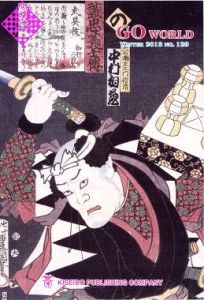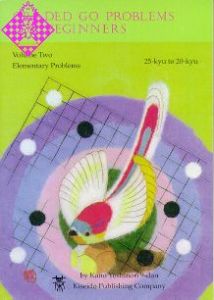Artikelnummer
LGZEIMGS
Making Good Shape
Masterings the Basics, Volume 3
206 Seiten, kartoniert, Kiseido, 1. Auflage 2002
Preface
Good shape is a subject that has received scant attention in Japanese go literature. Although references to shape are made in most books, there is no one book devoted exclusively to this subject. However, understanding and recognizing good shape is important for becoming a strong player and developing the intuition that will instantly guide you to finding the strongest moves in the opening and the middlegame fighting.
The brain is made up of two hemispheres whose functions are different but complimentary. The right hemisphere is superior in handling geomettical concepts and the left hemisphere is superior in handling analytical processes. Playing go involves an interesting interplay between these two abilities. The right hemisphere provides the geometrical vision necessary to see the shape that you wish to achieve while the left hemisphere provides the analysis that is needed to achieve that shape. Studying shape is an excellent vehicle for develand integrating both the geometrical and analytical powers of the brain.
Shapes are the building blocks of your groups. They determine whether your stones are working together efficiently or are sitting in each other's way. Good shape is a source of strength to build on, while bad shape often comes back to haunt you.
There are two aspects of shape. One is to make good shape for your own stones; the other is to spoil the shape of your opponent's. However, good shape is more than a static form; it is dynamic in the way it builds eye shape and stays ahead of the opponent in running battles while building more eye shape.
This book provides an extensive theoretical introduction to shape. The first chapter explains the efficient placement of stones. It then goes on to discuss thickness - how to use it and how to counter it, and how, if used improperly, can result in the overconcentration of stones. It continues by contrasting the concept of thick stones with that of thin stones, and, finally, what are heavy stones and what are light stones, and how these relate to the important concept of sabaki, which is, essentially, a method for making good shape.
The second chapter gives examples of the standard shapes, both good and bad, such as ponnuki, empty triangles, the center of three stones, the head of two and three stones, etc.
The core of this book is the 245 problems in Chapter Three. Not only do these provide practice material for the reader to internalize the lessons leamed in the theoretical sections of this book, they also provide a wealth of examples of good shape and the tesujis needed to achieve them. Even if you are unable to solve most of these problems, this should not deter you from pursuing them. The exposure you will get from the various techniques illustrated in these problems will go a long way in opening up your mind to new ways of thinking about go tactics and strategy.
The final chapter presents two professional games. They illustrate how shape is always foremost in the minds of professionals in deciding their moves.
Richard Bozulich and Rob van Zeijst
November 2002
Good shape is a subject that has received scant attention in Japanese go literature. Although references to shape are made in most books, there is no one book devoted exclusively to this subject. However, understanding and recognizing good shape is important for becoming a strong player and developing the intuition that will instantly guide you to finding the strongest moves in the opening and the middlegame fighting.
The brain is made up of two hemispheres whose functions are different but complimentary. The right hemisphere is superior in handling geomettical concepts and the left hemisphere is superior in handling analytical processes. Playing go involves an interesting interplay between these two abilities. The right hemisphere provides the geometrical vision necessary to see the shape that you wish to achieve while the left hemisphere provides the analysis that is needed to achieve that shape. Studying shape is an excellent vehicle for develand integrating both the geometrical and analytical powers of the brain.
Shapes are the building blocks of your groups. They determine whether your stones are working together efficiently or are sitting in each other's way. Good shape is a source of strength to build on, while bad shape often comes back to haunt you.
There are two aspects of shape. One is to make good shape for your own stones; the other is to spoil the shape of your opponent's. However, good shape is more than a static form; it is dynamic in the way it builds eye shape and stays ahead of the opponent in running battles while building more eye shape.
This book provides an extensive theoretical introduction to shape. The first chapter explains the efficient placement of stones. It then goes on to discuss thickness - how to use it and how to counter it, and how, if used improperly, can result in the overconcentration of stones. It continues by contrasting the concept of thick stones with that of thin stones, and, finally, what are heavy stones and what are light stones, and how these relate to the important concept of sabaki, which is, essentially, a method for making good shape.
The second chapter gives examples of the standard shapes, both good and bad, such as ponnuki, empty triangles, the center of three stones, the head of two and three stones, etc.
The core of this book is the 245 problems in Chapter Three. Not only do these provide practice material for the reader to internalize the lessons leamed in the theoretical sections of this book, they also provide a wealth of examples of good shape and the tesujis needed to achieve them. Even if you are unable to solve most of these problems, this should not deter you from pursuing them. The exposure you will get from the various techniques illustrated in these problems will go a long way in opening up your mind to new ways of thinking about go tactics and strategy.
The final chapter presents two professional games. They illustrate how shape is always foremost in the minds of professionals in deciding their moves.
Richard Bozulich and Rob van Zeijst
November 2002
| EAN | 9784906574735 |
|---|---|
| Gewicht | 300 g |
| Hersteller | Kiseido |
| Breite | 14,4 cm |
| Höhe | 21 cm |
| Medium | Buch |
| Erscheinungsjahr | 2002 |
| Autor | Rob van ZeijstRichard Bozulich |
| Sprache | Englisch |
| Auflage | 1 |
| ISBN-10 | 4906574734 |
| ISBN-13 | 9784906574735 |
| Seiten | 206 |
| Einband | kartoniert |
| Name | Kiseido Publishing Company |
|---|
iv Preface
vi Some Important Terms and Concepts
001 Chapter One: The Efficiency of Stones
017 Chapter Two: Examples of Good Shape
063 Chapter Three: 245 Problems
187 Chapter Four: Example Games
vi Some Important Terms and Concepts
001 Chapter One: The Efficiency of Stones
017 Chapter Two: Examples of Good Shape
063 Chapter Three: 245 Problems
187 Chapter Four: Example Games
Mehr von Kiseido
-
 Go World No. 1294,95 €
Go World No. 1294,95 € -
 Go World Archive120,00 €
Go World Archive120,00 € -
 Get Strong at the Opening19,50 €
Get Strong at the Opening19,50 € - Mehr von Kiseido





